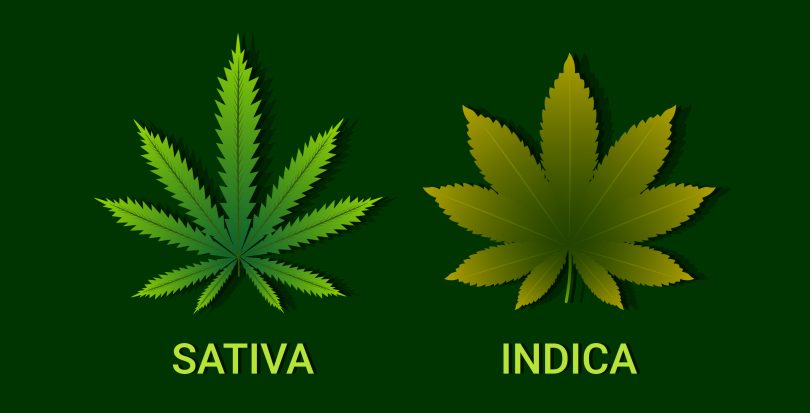When shopping for cannabis products, be it online or at a dispensary, you’ve probably noticed that aside from visibly posted THC content, the other way they are typically categorized is based on whether they are indica, sativa, or hybrid. Most people use these groups as a benchmark for gauging potency and effects. But how accurate is this method, and what are the true differences between these strain types?
Indica, or “in da couch” as it is casually referred to, is said to be the stronger of the two; delivering super relaxing, often sluggish, “couch-locked” effects. On the contrary, sativa strains have the reputation of hitting users with those creative, lively, and energetic highs. This has been widely accepted as fact among cannabis consumers for decades now. If you have ever been to a dispensary, it’s highly likely you’ve had a budtender recommend strains based on these classifications (spoiler alert, they will almost always recommend an indica… sometimes a hybrid).
However, as research continues to emerge about the plant, it turns out the real differences between strains is the specific blend of compounds (cannabinoids, terpenes, flavonoids, etc.) in each particular batch of flowers. As a matter of fact, the terms “sativa” and “indica” are rooted in geography and botany, having really nothing to do with what effects a user will experience. It’s like comparing apples around the world. In some regions they grow smaller or come in different colors, but they’re all still apples – just with a slight bit of variation based on where they are from. So for the sake of this article, think of cannabis like any other flowering plant, fruit, or vegetable.
Cannabis is a multifaceted plant with hundreds of active and inactive compounds working together synergistically. To minimize all that chemistry down to indica vs sativa makes very little sense and is actually, totally inaccurate. To learn more about the cannabis plant, make sure to subscribe to The Delta 8 Weekly Newsletter, your top source for all things weed-related as well as exclusive deals on delta-8 THC, delta 10, thcv, thcp, thc-o, hhc and even legal hemp-derived delta-9 THC.
What Are Indicas?
Cannabis indica refers to the intoxicating variety of cannabis that was originally discovered in the Hindu Kush Mountains of Northern India, where it grew comfortably in between 30-50 degrees latitude. In addition to being smoked, Cannabis indica was harvested for seeds, fiber, and hashish (hash) production (the world’s first cannabis concentrate). “Indica” technically means any plant that comes originally from India, although in the weed industry it has become synonymous with the stout, broad-leaf plants, believed to produce sedative effects and powerful body highs.
As far as cultivation goes, Indica plants are typically shorter and bushier producing dense bulky, nugs. There are many benefits to this smaller stature, first of which is that they require much less physical space to grow. They also flower considerably faster than Sativa strains, only taking about 6-8 weeks before you get a harvest. For these reasons, paired with the reputation of Indicas, they are most popular among modern growers and likely the reason you see more and more indica/hybrids on the market today.
More About Sativas
The exact origins of Sativa strains are less specific, although we do know that much of it hails from the latitudes of 0-30 degrees. Typically, it grew in warmer climates like Mexico, Columbia, Thailand, and Southeast Asia. The term “sativa” was also used to describe hemp plants found throughout Europe, where it was cultivated for seeds, fiber, and other practical uses.
Sativa strains are associated with the uplifting “head high” that people claim makes them feel connected and euphoric. Again, these effects aren’t necessarily due to the fact that they are sativas and simply that, but rather because strains coming from those parts of the world may have different combinations of compounds than hardy, mountain Indica strains. My guess would be that it has a lot to do with the sun and warmth.
Sativa plants are tall and lanky. On average they get around 10-12 feet tall, although some can exceed 20 feet. The leaves are thin and pointed and the nugs produced by these strains are typically longer and fluffier than indica flowers. Sativas grow well outdoors and often require less maintenance than indica plants. Despite that, they are less popular for cultivators, especially those doing indoor and greenhouse grows.
Defining Hemp
Hemp is a term used to classify certain varieties of cannabis that have less than 0.3 percent THC (by dry weight). This is the legal standard by which hemp is defined in the United States and throughout most of the world, although some countries are leaning now towards a 1 percent cutoff. Generally speaking, Hemp is used to describe Cannabis types that are non-intoxicating and harvested for its industrial purposes.
There is evidence of hemp cultivation and use that dates back roughly 10,000 years, leading many to believe that hemp was the first crop ever grown and harvested by man. Because hemp is so versatile and can be used to create a multitude of essential items like food, textiles, housing material, plastic, and even biofuel, one can presume that hemp has been a catalyst for some of our most important inventions throughout history.
Hemp isn’t used only for industrial reasons though. Smokable hemp/CBD flower is growing trend that has really gained a lot of traction in the U.S. market these last couple of years; although they are by far not as popular as THC/marijuana strains. Feminized Cannabis sativa flower that produces low levels of THC, also produces smokable buds that taste, look, and smell just like the marijuana you would find at a dispensary or on the street.
The most obvious difference between the two is that hemp/CBD flower doesn’t get you high. It may feel relaxing in the same way that cigarettes are relaxing, but there are no actual psychoactive effects. Personally, I feel like most hemp flowers seem to have the same underlying flavor and there is much less terpene variety in these strains compared to marijuana. Hemp flowers certainly have their place in the market though and can be great for curbing anxiety and depression, relieving pain, treating neurological disorders, or just relaxing without the high if that’s what you’re into.
Understanding Hybrids
Hybrid is a relatively new term used to classify cannabis that is bred from parents of two different strains. Theoretically, a hybrid can offer users the most beneficial medical and recreational properties from both parents, but in reality, it depends entirely on which traits get passed down during the breeding process.
To further complicate the issue of hybrids, there is no scientific evidence to support this dichotomy of cannabis types because on a molecular level, indica and sativa strains don’t have patterns that differentiate the two “types” from each other anyway. From a chemical standpoint, most strains on the market today can be classified as hybrids. Because, just stop to think about how unlikely it is that you would come across a strain that has the original parent genetics from hundreds of years ago. Not only is that close to impossible, but you’d likely be disappointed with how unrefined those flowers were compared to what’s available today.
Hybrid stains that display more characteristics from either side of the spectrum are labeled “indica-dominant” or “sativa-dominant”. Common notes you may see on a flower label at a dispensary include a sativa/indica ratio – for example, 60/40 indica/sativa – or you may just see the percentage of the dominant characteristics – 80 percent indica, or 70 percent sativa.
It’s worth noting that hybrids don’t have to be a blend of sativa and indica. Breeders often use both indica parents, or pair sativas with each other. Jack’s Dream is a good example of this, using two very popular sativa strains – Jack Herer and Blue Dream – to create a super sativa hybrid. Or Bubba Purps, a combination of Pre 98 Bubba Kush and Granddaddy Purps, both of which are well-known indicas.
Cannabinoids, Terpenes, and The Entourage Effect
To find a strain that will provide you with specific effects, you have to search beyond indica and sativa and look at the entire package instead – strain name and genetics, terpene blends, and cannabinoid content. In reality, the entire indica vs sativa vs hybrid trend is basically just a big marketing ploy anyway.
The cannabis plant is composed of roughly 400 different compounds – over 100 cannabinoids and close to 150 terpenes have been identified so far. The two most abundant compounds are THC (tetrahydrocannabinol) and CBD (cannabidiol). Strains that are high in THC are generally very low in CBD, and vice versa, although some 1:1 ratio strains do exist. Both indica and sativa strains can exhibit similar cannabinoid and terpene profiles.
Terpenes are a very large and diverse class of organic compounds that are produced by a wide variety of plants including herbs, trees, flowers, and fruit. In cannabis, they are secreted by the same glands that produce all the most dominant cannabinoids. If it weren’t for these flavorful, aromatic compounds, weed would be nowhere near as appealing as it is.
Not only do terps give cannabis its irresistible taste, but thanks to the entourage effect, they work synergistically with cannabinoids in the plant to offer us a better high and multitude of therapeutic benefits. Simply put, the entourage effect refers to the way different cannabinoids, terpenes, and flavonoids work together to offer health benefits you can only get when consuming the entire plant in its natural state. Even the slightest change in chemical profile (for example, switching out the limonene terp for myrcene, can result in noticeable changes in the way all the other compounds interact with each other, and thus, the effects felt but the consumer will vary as well.
Final Thoughts
To summarize, cannabis is so much more than just THC content, and indica versus sativa. With hundreds of active and inactive compounds all working together in this incredible plant, it’s no surprise that you get slightly different effects from every strain you consume. So, keep in mind that you’re short changing yourself and missing out on so many amazing flowers if you go straight for the indicas every time.
Thank you for stopping by CBD TESTERS, your hub for all things cannabis-related. Remember to subscribe to The Delta 8 Weekly Newsletter for more articles like this one and exclusive deals on flowers, vapes, edibles, and other legal products.










